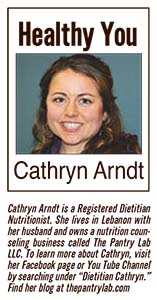Once again, it is upon us: the budding of spring, and with it comes the annual National Nutrition Month campaign put on by Registered Dietitians all over the U.S.
This year’s catch-phrase is “eat right, bite by bite.”
It encourages four specific ways to make small and sustainable changes to the way you eat. The goal is to make positive one-degree changes that have a “cumulative effect.”
Before I launch into these four points, let me offer a quick qualifier regarding the term “eat right.” When we say “eat right,” it often feels like we’re talking about fitting into a mold.
In our minds this mold consists of a list of dos and don’ts, with foods categorized as good and bad, right and wrong. Please ease any sense of angst that phrase dishes up.
Eating right means eating well for YOU. It is eating in a way that promotes health and prevents disease (as much as possible). It is not one-size-fits-all.
Of course, there are really great principles (which perhaps could be better described as “guidelines”) out there, but please don’t interpret eating “right” as an unattainable way of eating perfectly. It is simply not so.
There are four main ways/changes the Academy of Nutrition and Dietetics suggest to help one eat right, bite by bite: vary your diet; meal planning; cooking/meal prep; and seeing a Registered Dietitian Nutritionist.
Let’s discuss these suggestions in greater detail.
Vary Your Diet
Varying your diet means you don’t always eat the same things all the time. Variety does not have to look extreme or be too difficult. It can be as simple as buying one different vegetable, fruit or grain a week.
Variety gives you not only a break from what otherwise could feel like monotony, but also a wider spectrum of health-promoting components. These include water, fiber, vitamins, minerals and phytochemicals (powerful anti-inflammatory compounds in the color of the fruit).
Fiber is one topic that researchers are increasingly focusing upon as they realize how greatly it affects our gut bacteria (both the healthy and unhealthy kind). This changes many things about your overall health, including blood sugar control, immune function, hormone synthesis, etc.
It is important to note that having habits and patterns in your eating is 100 percent normal. In fact, it would be strange if you didn’t eat in some sort of pattern.
Eating variety doesn’t mean you can never eat the same thing twice in a day, week, or month. It just means you try something new frequently to maximize the health benefits available to you.
Changing your method of cooking or preparation is another way to add variety. Some people believe strongly in only raw foods or juicing, but research shows that there are benefits to various food preparation methods.
Eating both raw carrot sticks and those stewed in a soup are both beneficial. Consuming beans that were cooked with a little or no oil are both beneficial. You get the idea.
Healthy eating will not look the same throughout the season, either. Many berries and fruits are only accessible when they are in season. Here in the Northwest, we typically eat lots of berries in the summer but eat more citrus fruits in the winter due to their availability in stores. This is completely OK.
Meal Planning
This means exactly what it implies: in some way, shape or form, plan the ways you are going to eat and what you are going to eat. For many people, planning can be the linch-pin in getting started eating better. But if you don’t have some sort of direction, don’t be surprised if you don’t arrive at your destination.
Planning a meal can be as complex or simple as you wish it to be. In essence, meal planning means you figure out your health goals, know your budget, decide what you want to eat, shop for it and bring it home.
It can be the ready-made food from the grocery store or it could be the lettuce from your own backyard garden. It can be eating healthy foods out in a restaurant, or meals made at home. It simply means you have given some thought to how you will eat healthy. It doesn’t have to be 100 percent from scratch. This leads me to the next point regarding cooking and preparation.
Cooking/Meal Preparation
Let’s be honest, this point is one of THE most difficult of the four steps to make. Why? Because while many of us KNOW that we ought to eat right and plan our meals, the actual act of cooking and preparation requires certain, definite, and consistent action. That is hard to do.
At this very point, the old habits crack and begin to break. It also is difficult because it involves being in the kitchen, which, let’s face it, is not as common a skill as it once was. It is an activity that many people don’t enjoy and can “outsource” to others (hello, fast food).
Eating healthy will affect your time, goals and budget. However, don’t fall into an all-or-nothing approach. The fact that you can’t do 100-percent-from-scratch meals does not mean you can’t cook and eat healthfully.
Cooking at home gives you more control over the foods and ingredients you eat, whereas eating out puts you at the mercy of the restaurant. Yet, you can still make some excellent choices at eateries if you plan for it.
Visit a Registered Dietitian Nutritionist (RDN)
Oftentimes, people think they have to go to an RDN if their diet is really bad and their doctor refers them to one. This doesn’t have to be the case. It can’t hurt to get another set of eyes on those labs, or to hear some more thoughts on some goals that may work for you.
Dietitians get a bad rap for being “food Nazis.” Maybe they once were. Ultimately, though, their job is to know food, get to know you, and then to discover where the two coincide to make a better, healthier you.
In all your efforts to make healthy changes to your life diet (whether it be varying your diet, menu planning/cooking, prep or seeing an RDN), remember to never focus on food “just because.”
Eating well isn’t an end goal in and of itself. It is a springboard to launch you into being there for the people in your life, accomplishing the goals you have set and the purpose to which you are called .
That is healthy living!
– Cathryn Arndt is a Registered Dietitian Nutritionist (RDN). She owns a nutrition counseling business called The Pantry Lab LLC. She lives in the Lebanon area with her husband and toddler. Find her at thepantrylab.com or visit her Facebook page by searching under “Dietitian Cathryn.”





